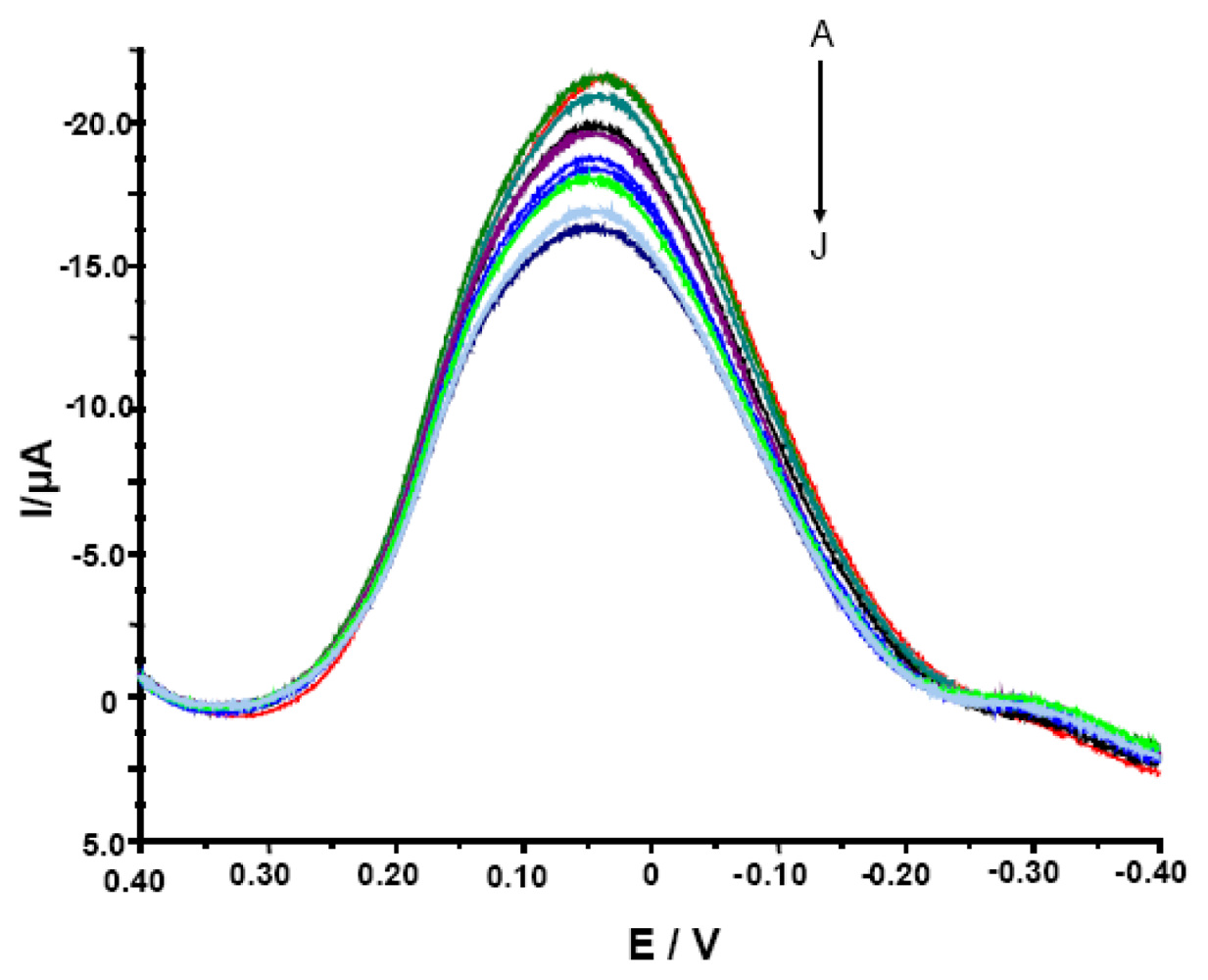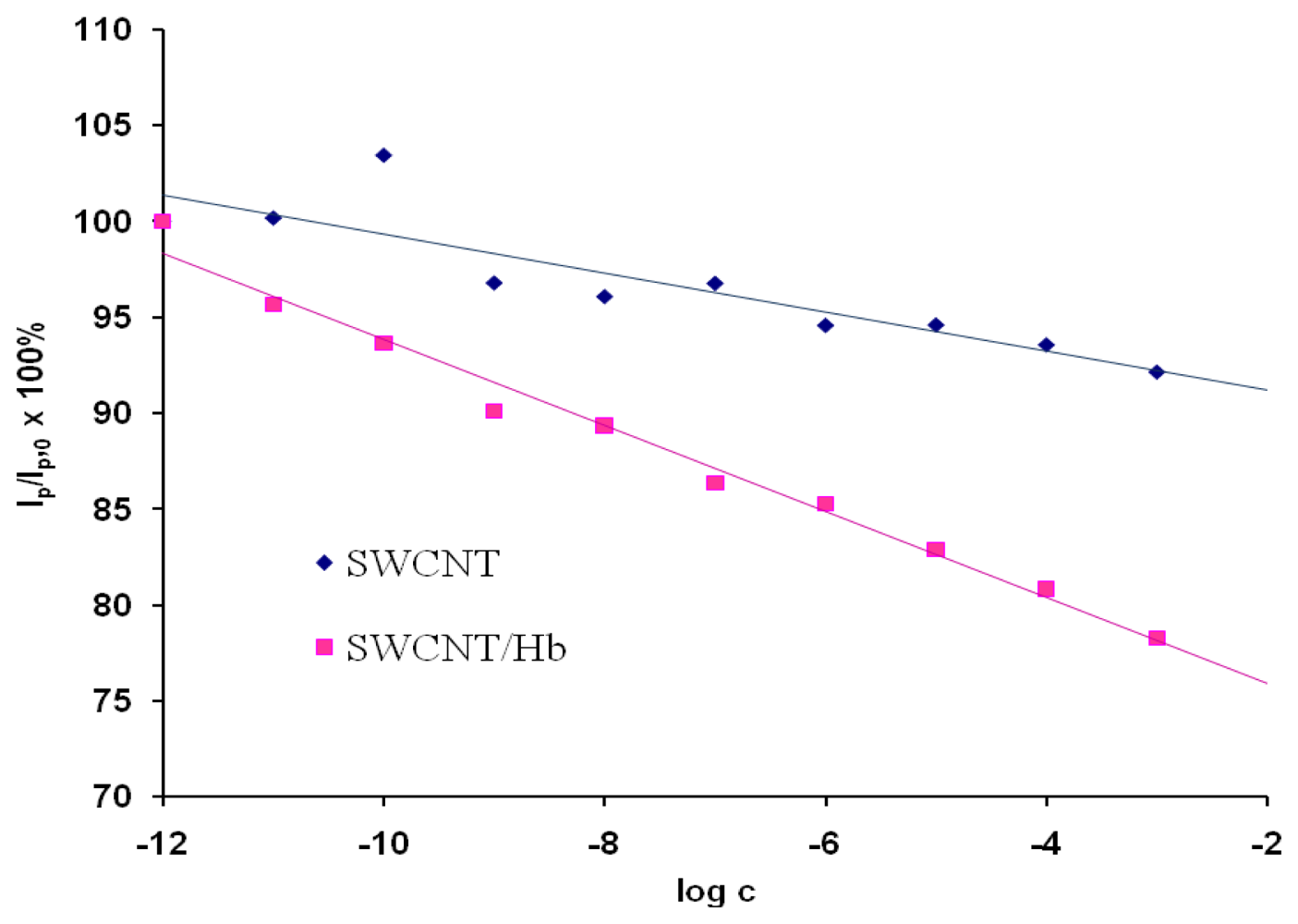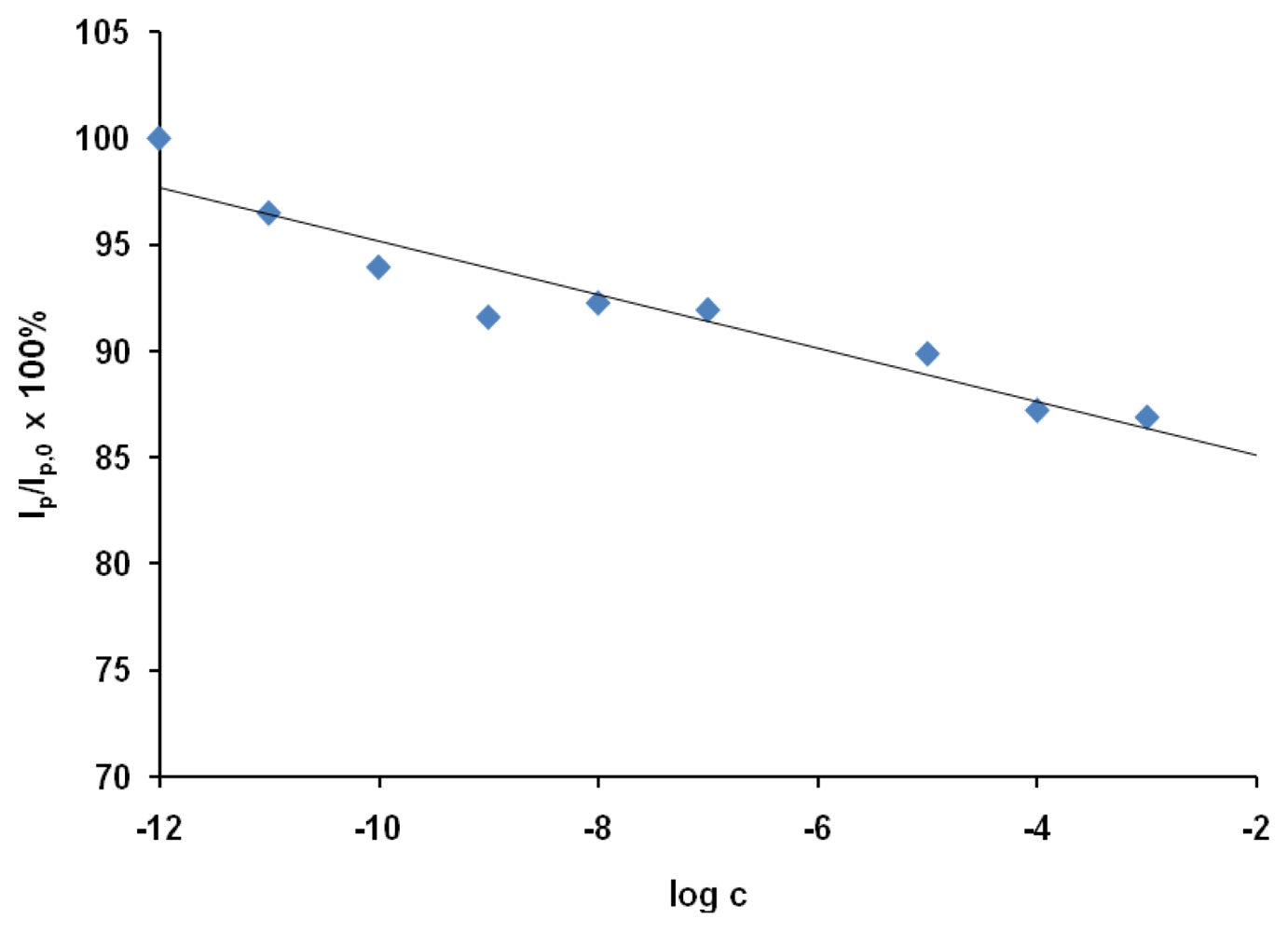A Voltammetric Biosensor Based on Glassy Carbon Electrodes Modified with Single-Walled Carbon Nanotubes/Hemoglobin for Detection of Acrylamide in Water Extracts from Potato Crisps
Abstract
:1. Introduction
2. Materials and Methods
2.1. Materials
2.2. Preparation of electrodes
2.3. Purification of SWCNTs
2.4. Modification of electrodes
2.5. Electrochemical measurements
2.6. Preparation of potato crisp water extracts
3. Results and Discussion
3.1. Characterisation of GCE/SWCNT/Hb electrodes
3.2. Amperometric responses of SWCNT/Hb modified glassy carbon electrode towards acrylamide
3.3. Detection of acrylamide in the presence of water extract from potato crisps using a glassy carbon electrode modified with hemoglobin
4. Conclusions
Acknowledgments
References
- Tareke, E.; Rydberg, P.; Karlsson, P.; Eriksson, S.; Törnqvist, M. Analysis of acrylamide, a carcinogen formed in heated foodstuffs. J. Agric. Food Chem. 2002, 50, 4998–5006. [Google Scholar]
- Ruden, C. Acrylamide and cancer risk – export risk assessments and the public debate. Food Chem. Toxicol. 2004, 42, 335–349. [Google Scholar]
- Friedman, M. Chemistry, biochemistry and safety of acrylamide. A review. J. Agric. Food Chem. 2003, 51, 4504–4526. [Google Scholar]
- Gökmen, V.; Şenyuva, H.Z.; Acar, J.; Sarıoğlu, K. Determination of acrylamide in potato chips and crisps by high-performance liquid chromatography. J. Chrom. A 2005, 1088, 193–199. [Google Scholar]
- Becalski, A.; Lau, B.P.-Y.; Lewis, D.; Seaman, S.W. Acrylamide in foods: occurrence, sources and modelling. J. Agric. Food Chem. 2003, 51, 802–808. [Google Scholar]
- Mottram, D.S.; Wedzicha, B.L.; Dodson, A.T. Acrylamide is formed in the Maillard reaction. Nature 2002, 419, 448–449. [Google Scholar]
- Stadler, R.H.; Blank, I.; Varga, N.; Robert, F.; Hau, J.; Guy, P.A.; Robert, M.-C.; Riediker, S. Acrylamide from Maillard reaction products. Nature 2002, 419, 449. [Google Scholar]
- Zyzak, D.V.; Sanders, R.A.; Stojanovic, M.; Tallmadge, D.H.; Eberhart, B.L.; Ewald, D.K.; Gruber, D.C.; Morsch, T.R.; Strothers, M.A.; Rizzi, G.P.; Villagran, M.D. Acrylamide formation mechanism in heated foods. J. Agric. Food Chem. 2003, 51, 4782–4787. [Google Scholar]
- Mizukami, Y.; Kohata, K.; Yamaguchi, Y.; Hayashi, N.; Sawai, Y.; Chuda, Y.; Ono, H.; Yada, H.; Yoshida, M. Analysis of acrylamide in green tea by gas chromatography-mass spectrometry. J. Agric. Food Chem. 2006, 54, 7370–7377. [Google Scholar]
- Hoenicke, K.; Gatermann, R.; Harder, W.; Hartig, L. Analysis of acrylamide in different foodstuffs using liquid chromatography-tandem mass spectrometry and gas chromatography-tandem mass spectrometry. Anal. Chim. Acta 2004, 520, 207–215. [Google Scholar]
- Robert, F.; Vuataz, G.; Pollien, P.; Saucy, F.; Alonso, M.-I.; Bauwens, I.; Blank, I. Acrylamide firmation from asparagine under low moisture Maillard reaction conditions. 2. Crystalline vs amorphous model systems. J. Agric. Food Chem. 2005, 53, 4628–4632. [Google Scholar]
- Ignatov, O.V.; Rogatcheva, S.M.; Kozulin, S.V.; Khorkina, N.A. Acrylamide and acrylic acid determination using respiratory activity of microbial cells. Biosens. Bioelectron. 1996, 12, 105–111. [Google Scholar]
- Kleefish, G.; Kreutz, C.; Bargon, J.; Silva, G.; Schalley, C. A. Quartz microbalance sensor for the detection of acrylamide. Sensors 2004, 4, 136–146. [Google Scholar]
- Stobiecka, A.; Radecka, H.; Radecki, J. Novel voltammetric biosensor for determining acrylamide in food samples. Biosens. Bioelectron. 2007, 22, 2165–2170. [Google Scholar]
- Scheller, F.W.; Bistolas, N.; Liu, S.; Janchen, M.; Katterle, M.; Wollenberger, U. Thirty years of haemoglobin electrochemistry. Adv. Colloid. Interface Sci. 2005, 116, 111–120. [Google Scholar]
- Hagmar, L.; Wirfält, E.; Paulsson, B.; Törnqvist, M. Differences in hemoglobin adduct levels of acrylamide in the general population with respect to dietary intake, smoking habits and gender. Mutat. Res. 2005, 580, 157–165. [Google Scholar]
- Paulsson, B.; Grawe, J.; Törnqvist, M. Hemoglobin adducts and micronucleus frequencies in mouse and rat after acrylamide or N-methylolacrylamide treatment. Mutat. Res. 2002, 516, 101–111. [Google Scholar]
- Luo, X.; Morrin, A.; Killard, A.J.; Smyth, M.R. Application of nanoparticles in electrochemical sensors and biosensors. Electroanalysis 2006, 18, 319–326. [Google Scholar]
- Wang, J. Nanoparticle-based electrochemical bioassays of proteins. Electroanalysis 2007, 19, 769–776. [Google Scholar]
- Luo, H.; Shi, Z.; Li, N.; Gu, Z.; Zhuang, Q. Investigation of the electrochemical and electrocatalytic behavior of single-wall carbon nanotube film on a glassy carbon electrode. Anal. Chem. 2001, 73, 915–920. [Google Scholar]
- Yin, Y.; Lü, Y.; Wu, P.; Cai, C. Direct electrochemistry of redox proteins and enzymes promoted by carbon nanotubes. Sensors 2005, 5, 220–234. [Google Scholar]
- Yang, M.; Qu, F.; Li, Y.; He, Y.; Shen, G.; Yu, R. Direct electrochemistry of hemoglobin in gold nanowire array. Biosens. Bioelectron. 2007, 23, 414–420. [Google Scholar]
- Gu, H.-Y.; Yu, A.-M.; Chen, H.-Y. Direct electron transfer and characterization of hemoglobin immobilized on a Au colloid-cysteamine-modified gold electrode. J. Electroanal. Chem. 2001, 516, 119–126. [Google Scholar]
- Zhang, L.; Jiang, X.; Wang, E.; Dong, S. Attachment of gold nanoparticles to glassy carbon electrode and its application for the direct electrochemistry and electrocatalytic behavior of hemoglobin. Biosens. Bioelectron. 2005, 21, 337–345. [Google Scholar]
- Han, X.; Cheng, W.; Zhang, Z.; Dong, S.; Wang, E. Direct transfer between hemoglobin and a glassy carbon electrode facilitated by lipid-protected gold nanoparticles. Biochim. Biophys. Acta 2002, 1556, 273–277. [Google Scholar]
- Wang, C.; Yang, C.; Song, Y.; Gao, W.; Xia, X. Adsorption and direct electron transfer from hemoglobin into a three-dimensionally ordered macroporous gold film. Adv. Funct. Mater. 2005, 15, 1267–1275. [Google Scholar]
- Wang, Y.; Qian, W.; Tan, Y.; Ding, S.; Zhang, H. Direct electrochemistry and electroanalysis of hemoglobin adsorbed in self-assembled films of gold nanoshells. Talanta 2007, 72, 1134–1140. [Google Scholar]
- Chen, S.; Yuan, R.; Chai, Y.; Zhang, L.; Wang, N.; Li, X. Amperometric third-generation hydrogen peroxide biosensor based on the immobilization of hemoglobin on multiwall carbon nanotubes and gold colloidal nanoparticles. Biosens. Bioelectron. 2007, 22, 1268–1274. [Google Scholar]
- Zhang, R.; Wang, X.; Shiu, K.-K. Accelerated direct electrochemistry of hemoglobin based on hemoglobin-carbon nanotube (Hb-CNT) assembly. J. Colloid Interface Sci. 2007, 316, 517–522. [Google Scholar]
- Qi, H.; Zhang, C.; Li, X. Amperometric third-generation hydrogen peroxide biosensor incorporating multiwall carbon nanotubes and hemoglobin. Sens. Actuators, B 2006, 114, 364–370. [Google Scholar]
- Zhang, Y.; Cheng, W.; Li, S.; Li, N. Direct electron transfer of hemoglobin on DDAB/SWNTs film modified Au electrode and its interaction with Taxol. Colloids Surf., A 2006, 286, 33–38. [Google Scholar]
- Yang, P.; Zhao, Q.; Gu, Z.; Zhuang, Q. The electrochemical behavior of hemoglobin on SWNTs/DDAB film modified glassy carbon electrode. Electroanalysis 2004, 16, 97–100. [Google Scholar]
- Ma, G.-X.; Wang, Y.-G.; Wang, C.-X.; Lu, T.-H.; Xia, Y.-Y. Hemoglobin immobilized on whisker-like carbon composites and its direct electrochemistry. Electrochim. Acta 2008, 53, 4748–4753. [Google Scholar]
- Iijima, S. Carbon nanotubes: past, present, and future. Physica B 2002, 323, 1–5. [Google Scholar]
- Goyanes, S.; Rubiolo, G.R.; Salazar, A.; Jimeno, A.; Corcuera, M.A.; Mondragon, I. Carboxylation treatment of multiwalled carbon nanotubes monitored by infrared and ultraviolet spectroscopies and scanning probe microscopy. Diamond Relat. Mater. 2007, 16, 412–417. [Google Scholar]
- Su, S.-H.; Chiang, W.-T.; Lin, C.-C.; Yokoyama, M. Multi-wall carbon nanotubes: Purification, morphology and field emission performance. Physica E 2008, 40, 2322–2326. [Google Scholar]
- Profumo, A.; Fagnoni, M.; Merli, D.; Quartarone, E.; Protti, S.; Dondi, D.; Albini, A. Multiwalled carbon nanotubes chemically modified gold electrode for inorganic as apeciation and Bi(III) determination. Anal. Chem. 2006, 78, 4194–4199. [Google Scholar]
- Bard, A.J.; Faulkner, L.R. Electrochemical methods. Fundamentals and applications; John Wiley and sons, Inc.: New York, 2001. [Google Scholar]
- Osteryoung, J. Voltammetry for the future. Acc. Chem. Res. 1993, 26, 77–83. [Google Scholar]
- Osteryoung, J.G.; Osteryoung, R.A. Square wave voltammetry. Anal. Chem. 1985, 57, 101A–110A. [Google Scholar]
- Fan, C.; Liu, X.; Pang, J.; Li, G.; Scheer, H. Highly sensitive voltammetric biosensor for nitric oxide based on its high affinity with hemoglobin. Anal. Chim. Acta 2004, 523, 225–228. [Google Scholar]
List of abbreviations
| CNT | carbon nanotubes |
| CV | cyclic voltammetry |
| DDAB | dimethyldioctadecyl-ammonium bromide |
| DMF | dimethylformamide |
| EDC | 1-ethyl-3-(3-dimethylaminopropyl) carbodiimide |
| GCE | glassy carbon electrode |
| GCE/SWCNT/Hb | glassy carbon electrodes modified with single-walled carbon nanotubes and hemoglobin |
| GC-MS | gas chromatography-mass spectrometry |
| GC-MS-MS | gas chromatography-tandem mass spectrometry |
| Hb | hemoglobin |
| HPLC-MS | high-performance liquid chromatography-mass spectrometry |
| LC-MS-MS | liquid chromatography- tandem mass spectrometry |
| MWCNTs | multiwall carbon nanotubes |
| Nafion-Hb-CNT/GCE | glassy carbon electrode modified with carbon nanotubes, hemoglobin and Nafion |
| OSWV | Osteryoung square wave voltammetry |
| QCM | quartz crystal microbalance |
| SCE | saturated calomel electrode |
| SWCNT-COOH | acid treated single-walled carbon nanotubes |
| SWCNTs | single-walled carbon nanotubes |


 ) and SWCNT/Hb, Ep,0=44 mV, n=3, 0.9<SD<4.4 (
) and SWCNT/Hb, Ep,0=44 mV, n=3, 0.9<SD<4.4 (
 ).
).
 ) and SWCNT/Hb, Ep,0=44 mV, n=3, 0.9<SD<4.4 (
) and SWCNT/Hb, Ep,0=44 mV, n=3, 0.9<SD<4.4 (
 ).
).

© 2008 by the authors; licensee Molecular Diversity Preservation International, Basel, Switzerland. This article is an open-access article distributed under the terms and conditions of the CreativeCommons Attribution license (http://creativecommons.org/licenses/by/3.0/).
Share and Cite
Krajewska, A.; Radecki, J.; Radecka, H. A Voltammetric Biosensor Based on Glassy Carbon Electrodes Modified with Single-Walled Carbon Nanotubes/Hemoglobin for Detection of Acrylamide in Water Extracts from Potato Crisps. Sensors 2008, 8, 5832-5844. https://doi.org/10.3390/s8095832
Krajewska A, Radecki J, Radecka H. A Voltammetric Biosensor Based on Glassy Carbon Electrodes Modified with Single-Walled Carbon Nanotubes/Hemoglobin for Detection of Acrylamide in Water Extracts from Potato Crisps. Sensors. 2008; 8(9):5832-5844. https://doi.org/10.3390/s8095832
Chicago/Turabian StyleKrajewska, Agnieszka, Jerzy Radecki, and Hanna Radecka. 2008. "A Voltammetric Biosensor Based on Glassy Carbon Electrodes Modified with Single-Walled Carbon Nanotubes/Hemoglobin for Detection of Acrylamide in Water Extracts from Potato Crisps" Sensors 8, no. 9: 5832-5844. https://doi.org/10.3390/s8095832
APA StyleKrajewska, A., Radecki, J., & Radecka, H. (2008). A Voltammetric Biosensor Based on Glassy Carbon Electrodes Modified with Single-Walled Carbon Nanotubes/Hemoglobin for Detection of Acrylamide in Water Extracts from Potato Crisps. Sensors, 8(9), 5832-5844. https://doi.org/10.3390/s8095832



